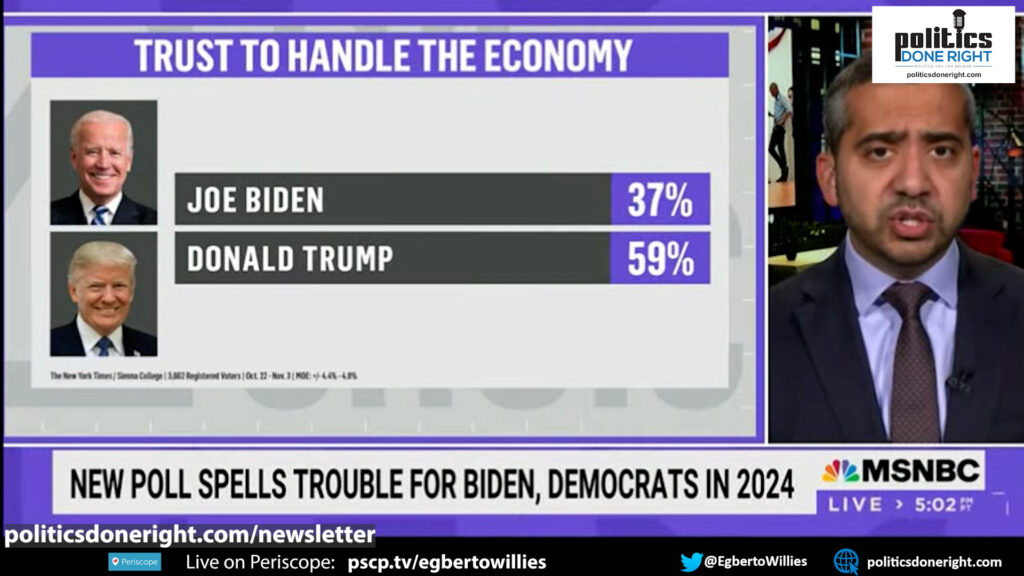President Joe Biden’s poll numbers are tanking. Mehdi Hasan points out why Democrats should calm down. There is much work to do.
Mehdi Hasan: Dems, Calm Down!
In an era where political discourse is characterized by immediacy and often alarmism, Mehdi Hasan provides a counter-narrative to the panic stirred by President Joe Biden’s sinking poll numbers as detailed in a recent New York Times and Sienna College poll. Hasan’s call for calm is not just a stoic dismissal of troubling indicators; it is a strategic appeal to perspective, historical context, and the proven resilience of the Democratic platform when it engages effectively with its grassroots.
In this video clip:
- Mehdi Hasan emphasizes that despite President Biden’s low poll numbers and the public’s apparent preference against a 2020 election rerun between Biden and Trump, Democrats should maintain perspective and remain calm.
- The New York Times and Sienna College poll suggests Trump would win decisively if the election were held now, based on his leads in key battleground states, contrasting with Biden’s victory in all those states in 2020.
- The poll highlights Biden’s age and perceived lack of mental sharpness as significant concerns for voters, in contrast to a lesser degree of concern for Trump’s age and mental acuity.
- Hasan points out the potential for Democrats to regain ground by focusing on their successes, like maintaining control of the Senate and combating a ‘red wave’ in the House during the midterms by emphasizing abortion and voting rights.
- The recommendation is for Democrats to move away from high-level consultancy and engage with grassroots movements, offering a clear pathway to hope and addressing the economic and social issues affecting ordinary Americans to improve their standing before the next election.
The poll’s findings are indeed unsettling for Democrats: Trump’s hypothetical victory in key battleground states and Biden’s precarious standing on issues of age and mental fitness are loud wake-up calls. However, these numbers, stark as they may be, are snapshots in time. They capture a moment but not a destiny. Hasan encourages us to look beyond the immediacy of these figures to understand the broader electoral landscape and the potential for political strategy to reshape outcomes.
Here lies the critical distinction between momentary panic and strategic response. Hasan references historical parallels with past presidents like Barack Obama and Ronald Reagan, who also faced polling deficits a year out from elections they would go on to win. This isn’t to suggest that history will necessarily repeat itself, but rather to remind Democrats that the script of political fortunes is not irrevocably written so far from Election Day.
The deeper issue at hand—and one that resonates with the progressive movement—is the dissonance between economic indicators and public sentiment. Despite positive signs like consumer spending and low unemployment, the electorate’s trust in Trump over Biden on economic matters is a sobering revelation. It speaks to a narrative battle lost, where the figures of macroeconomic success have failed to translate into a felt sense of prosperity and security among voters. Herein lies a profound challenge for the Democratic party: to redefine the economic conversation in terms that resonate with the lived experiences of ordinary Americans.
We must execute on a grassroots approach to politics, where the focus shifts from high-level political strategizing to on-the-ground activism and engagement with communities. It is within these spaces that the abstract promises of politicians are translated into concrete realities. Democrats have shown, particularly through the recent defense of Senate seats and prevention of a Republican sweep in the House, that a focused message on rights and social issues has traction.
The progressive path forward, then, is not merely one of messaging but of profound engagement with the socioeconomic realities of the electorate. Democrats must harness the disquietude within American society and channel it into a vision that not only critiques the status quo but also offers a tangible, achievable alternative. This requires an acknowledgment of the systemic inequities exacerbated by the economic policies of the past and a bold reimagining of the future.
We must empower the underrepresented and address the economic and social disparities that have long plagued American society. We must put out a call to “work the grassroots,” a call to action that resonates deeply with progressive activism, emphasizing the need for policy and change that is “organic from within,” stemming from the needs and aspirations of the communities that make up the fabric of the nation.
In the final analysis, Hasan’s message to Democrats is sober reflection, strategic calm, and proactive engagement. It is a recognition that the tides of political favor are amenable to those who can effectively engage with the hearts and minds of the populace, grounding lofty political ideals in the soil of community needs and aspirations. As the clock ticks down to the next presidential election, the progressive movement stands at a crossroads where the voices from the grassroots could decide the direction of the country’s political future.
Viewers are encouraged to subscribe and join the conversation for more insightful commentary and to support progressive messages. Together, we can populate the internet with progressive messages that represent the true aspirations of most Americans.

